Ijraset Journal For Research in Applied Science and Engineering Technology
- Home / Ijraset
- On This Page
- Abstract
- Introduction
- Conclusion
- References
- Copyright
Intelligent IoT-Based Flood Monitoring and Alerting System using Raspberry Pi
Authors: Devi. M, Rajeswari. R
DOI Link: https://doi.org/10.22214/ijraset.2024.64740
Certificate: View Certificate
Abstract
Floods are one of the most destructive natural disasters, causing significant loss of life and property. Early detection and timely intervention are crucial in mitigating the impacts of floods. The \"Intelligent IoT-Based Flood Monitoring and Alerting System\" is an innovative solution that leverages the power of the Internet of Things (IoT) to monitor water levels and predict potential flooding events. This system uses low-cost and easily accessible hardware such as a Raspberry Pi, sensors, LCD, buzzer and a cloud-based platform to provide real-time flood monitoring. The system continuously collects data on water levels, environmental conditions, and other relevant metrics, and processes this data to issue early warnings and alerts to local authorities and residents. Through an intuitive web interface, users can monitor flood-prone areas and receive notifications when water levels reach dangerous thresholds. The system aims to enhance disaster preparedness, reduce human and material losses, and improve the efficiency of flood management.
Introduction
I. INTRODUCTION
Floods are recurring natural events that can wreak havoc on communities and economies. Despite advances in meteorology and flood management, many regions still struggle with adequate early warning systems, leading to catastrophic damages. Traditional flood monitoring systems often lack the capability to provide real-time, localized, and actionable insights that can help authorities respond quickly.
In recent years, the Internet of Things (IoT) has emerged as a game-changer in various fields, including environmental monitoring. IoT-based systems offer real-time data collection, analysis, and communication at a fraction of the cost of traditional systems. By integrating sensors, microcontrollers, and wireless communication technologies, IoT systems enable intelligent and automated monitoring of critical parameters, such as water levels, precipitation, and soil moisture.
This project focuses on using a Raspberry Pi, a widely popular single-board computer, to build a cost-effective and scalable flood monitoring system. The Raspberry Pi is equipped with various sensors (such as water level sensors and environmental sensors) to gather data, process it, and send alerts if flood risks are detected. The system also integrates a cloud platform to store and analyze the collected data and offer real-time alerts to end-users through a web interface or mobile notifications. This IoT-based flood monitoring system will help mitigate the impact of floods by providing early warnings, allowing for timely evacuations and preparedness measures. Furthermore, the system can be integrated with existing flood management strategies to enhance resilience in vulnerable areas.
This project aims to demonstrate the feasibility of using IoT-based solutions for smart flood monitoring and provide a practical, affordable, and scalable approach for flood-prone regions around the world.
II. RELATED WORK
- Flood Sensor Network using IoT (2017): In a study by V. Srinivasan et al., an IoT-based flood monitoring system which utilizes various sensors to measure the water levels and transmits data to a cloud-based system. The system used the ESP8266 module for wireless communication and sent alerts through SMS or email. The data was stored on a cloud database and could be accessed via a mobile app. This system focused real-time monitoring but was limited by the absence of predictive flood detection and environmental parameters like rainfall or soil humidity.
- Smart Flood Monitoring System for Urban Areas (2018): In this approach, Kumar et al. proposed an IoT-based flood monitoring system using a Raspberry Pi and various sensors. The system utilized MQTT protocol for sending data to a cloud-based server where real-time analytics were performed to determine flood risks. The system issued alerts via SMS and email based on predefined thresholds for water levels. Machine learning techniques for advanced flood prediction was unavailable in this system.
- Real-time Flood Prediction and Warning System (2020): Another notable project integrated IoT with machine learning and artificial intelligence (AI) to predict floods in urban areas. It uses different sensors and weather forecast data to predict flood patterns. Real-time flood prediction, and data was processed on a cloud server was done with neural networks. This approach showed the potential of combining AI with IoT in real-time flood management, but was expensive for areas with limited infrastructure.
- Low-Cost Smart Flood Detection System Using IoT (2020): In this work, M. Subash et al. proposed a low-cost flood monitoring system that utilized Raspberry Pi and Arduino platforms along with water level and environmental sensors. The system communicated via LoRa (Long Range) technology to reduce energy consumption, and data was transmitted to a cloud platform for further processing. The system provided real-time alerts through SMS and a web dashboard. This approach was effective for remote areas with limited internet access but required improvements in scalability and ease of deployment.
- City-Wide Flood Alert System Using IoT (2021): Researchers at Stanford University developed an IoT-based system that was integrated into a city-wide flood management strategy. This system used real-time flood prediction algorithms and IoT sensors installed in different locations across the city. Data was collected from various IoT devices, and predictions were made based on data analytics to assist city officials in decision-making. This system showed promise in integrating IoT-based flood monitoring with urban planning but required significant infrastructure investments.
III. PROPOSED WORK
This project aims to develop a real time flood monitoring and warning system using Raspberry Pi and different IoT sensors for providing real-time flood monitoring and early warnings in flood-prone areas. The system will continuously collect environmental data such as water levels, rainfall, etc., from sensors which will be processed by the Raspberry Pi.
Using threshold-based alerts and predictive analytics powered by machine learning models, the system will issue early warnings when flood risks are detected, sending SMS, emails, or mobile notifications to authorities and residents. This system will also integrate with a cloud platform for storing historical data, visualizing trends, and conducting more advanced flood prediction.
The system will be scalable and low-cost, making it suitable for large geographic areas and rural regions. It will also be energy-efficient, with low-power sensors and optional solar power integration for off-grid deployment.
The user-friendly web interface will display real-time data, alerts, and historical trends, helping stakeholders make timely decisions. By leveraging IoT and cloud computing, the system aims to improve disaster preparedness and reduce the impact of floods on vulnerable communities.
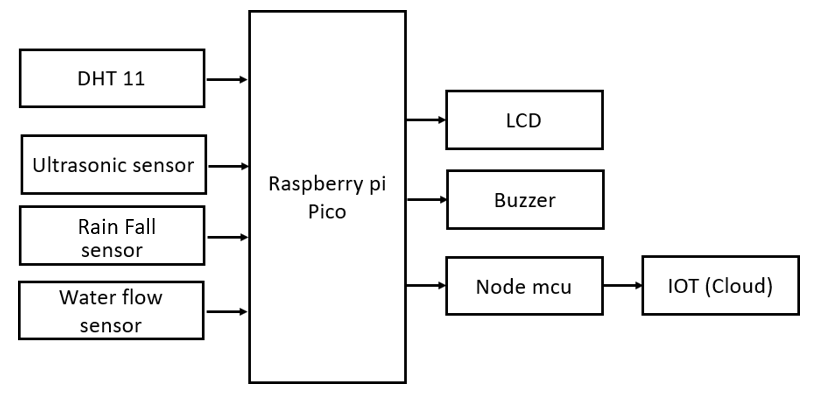
Fig. 1 Block diagram
A. Working
The IoT-based flood monitoring system uses a Raspberry Pi and various sensors (e.g., water level, rainfall, humidity) to collect real-time environmental data. This processor process the data, analyses flood risks using threshold-based alerts. If a flood risk is identified, the system triggers SMS, email, or mobile notifications to local authorities, residents and also alert through buzzer. Data is stored on a cloud platform for historical analysis and advanced flood prediction using machine learning.
The system is scalable, low-cost, and energy-efficient, making it suitable for large and remote areas. A web interface displays real-time data and alerts for decision-making.
B. Hardware Description
1) Raspberry Pi: The central computing unit of the system, responsible for collecting, processing, and transmitting data from sensors. It processes this information to detect critical water levels and sends alerts via SMS or email. The Raspberry Pi also handles real-time alert generation based on flood risks.
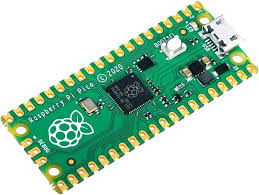
Fig. 2 Raspberry Pi Pico
2) Water Level Sensor (Ultrasonic): Used to measure the water level in rivers, lakes, or other bodies of water. The sensor emits ultrasonic waves and calculates the distance to the water's surface, helping detect potential flooding when water levels exceed critical thresholds.

Fig. 3 Ultrasonic Sensor
3) Rainfall Sensor (Rain Gauge): Measures the intensity of rainfall, a key indicator of potential floods. It provides real-time data on precipitation rates and contributes to predicting flood risks, particularly in regions prone to heavy rainfall.

Fig. 4 Rainfall Sensor
4) Temperature Sensors (DHT11): It is a low-cost digital temperature and humidity sensor that provides accurate temperature readings. It communicates with microcontrollers like Raspberry Pi via a digital signal, requiring only one data pin for operation. The sensor is suitable for basic environmental monitoring applications in IoT-based systems, providing reliable data for flood prediction and environmental assessments.
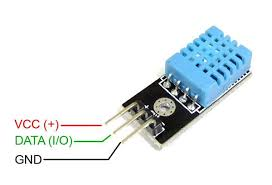
Fig. 5 Temperature Sensor
5) Water Flow Sensor (YF-S201): It measures the rate of water flow in pipes, rivers, or other water bodies. It operates by detecting the movement of water through a rotor or turbine, generating pulses that are proportional to the flow rate. This sensor helps monitor water movement, which is crucial for flood forecasting and managing water systems.
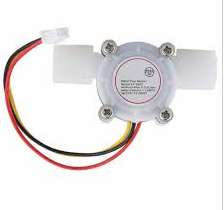
Fig. 6 Water Flow Sensor
6) LCD: It shows real-time sensor data, such as water levels, temperature, and humidity, providing immediate visual feedback at the monitoring location. It helps users quickly assess flood risks without needing to access the web interface. The LCD is connected to the Raspberry Pi and controlled via Python scripts, offering a convenient local display of key metrics.

Fig. 7 Liquid Crystal Display
7) Buzzer: It serves as an audible alert for flood risks, triggering a loud sound when water levels exceed predefined thresholds. It ensures immediate local notification, especially in areas without access to mobile networks or internet. The buzzer is activated through the Raspberry Pi’s GPIO pins using Python scripts, providing a critical audio warning in emergencies.
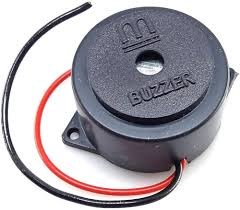
Fig. 8 Buzzer
8) NodeMCU: The NodeMCU is a low-cost, Wi-Fi-enabled microcontroller used to connect sensors to the internet in this project. It enables wireless communication between the flood monitoring system and the cloud, allowing for remote data transmission and real-time monitoring.
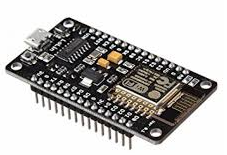
Fig. 9 NodeMCU
C. Software Description
Thonny is a user-friendly IDE, featuring an easy to interface and built-in debugger to aid learning. It allows users to track variables and step through code execution, making debugging easier. It also supports MicroPython, making it suitable for programming microcontrollers like the Raspberry Pi Pico. Thonny helps to:
- Write Python Code: Simple, clear coding interface for sensor data collection, processing, and alert generation.
- Debug: Thonny’s built-in debugger helps troubleshoot issues in real time, ensuring smooth interaction between hardware and software.
- Test: Run and test scripts on the Raspberry Pi, ensuring correct sensor readings and alert mechanisms.
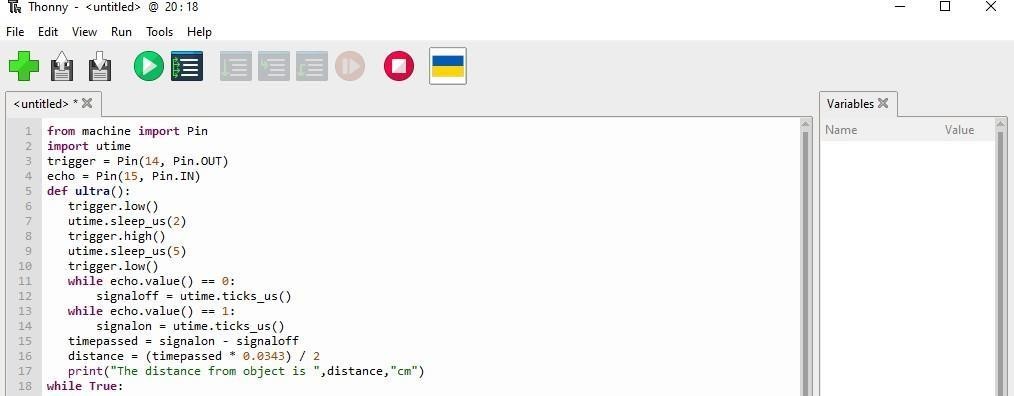
Fig. 10 Python Code
D. Result:
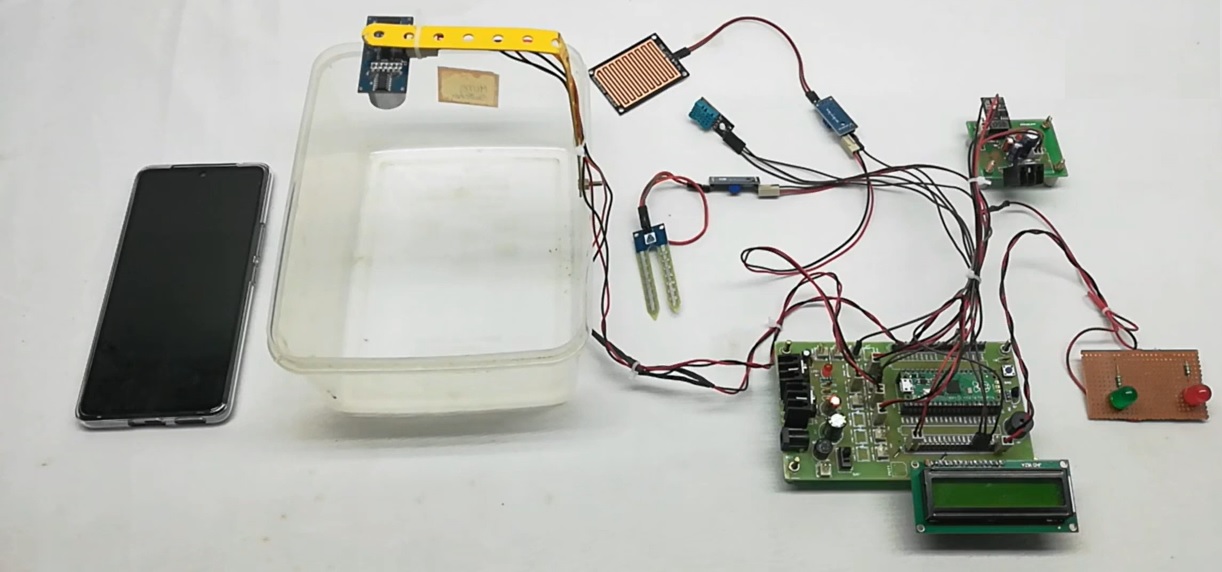
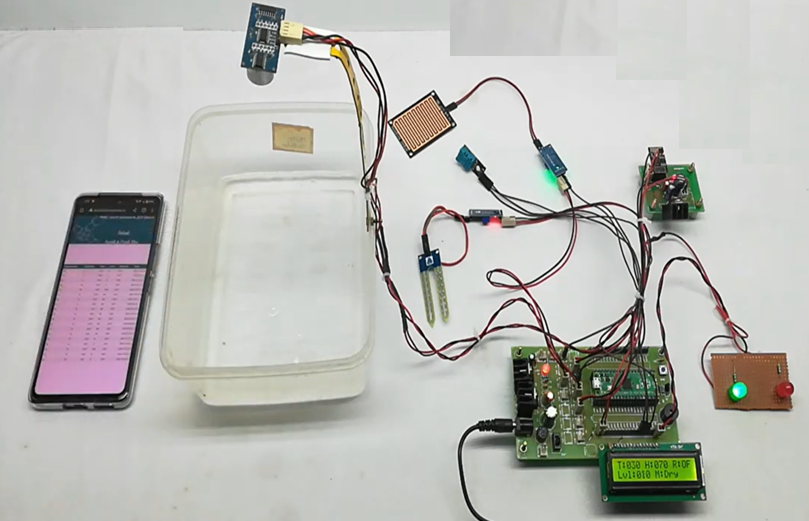
Fig. 11 Hardware Implementation
This proposed system is implemented on raspberry pi pico processor with python ide. The above figures shows the experimental setup of flood monitoring and alerting system. This system successfully detects and alerts users about potential flood risks. For example, when the water level sensor detects a water level exceeding the predefined threshold value, the system triggers the given actions. This system also uploads the data to the cloud for further analysis and future flood prediction.
Conclusion
This intelligent IoT-based flood monitoring system provides an efficient solution for detecting floods early by using sensors to measure water levels, temperature, and humidity. When a potential flood risk is detected, the system sends immediate alerts via SMS, email, and activates a buzzer for local warnings. An LCD display shows real-time data, allowing on-site monitoring. The system also uploads data to the cloud for analysis, improving future flood predictions. Affordable and easy to deploy, it enhances safety by giving communities timely warnings and helping them prepare in advance, reducing the impact of floods.
References
[1] D. Mysar and M.J. Babu, “Real Time Monitoring of Water Level Variation in Rivers and Flood Alerting System using ARM7”, International Journal of Advanced Research in Computer and Communication Engineering, vol. 4, no. 8, pp. 392-396, 2015. [2] N. Ahmad et al., “Flood Prediction and Disaster Risk Analysis using GIS based Wireless Sensor Networks: A Review”, Journal of Basic and Applied Scientific Research, vol. 3, no. 8, pp. 632- 643, 2013. [3] Bande, S.; Shete, V.V. “Smart flood disaster prediction system using IoT & neural networks”. In Proceedings of the 2017 International Conference on Smart Technologies for Smart Nation (SmartTechCon), Bangalore, India, 17–19 August 2017. [4] M. Borga et al., “Surveying flash floods: gauging the ungauged extremes,” Hydrological processes, vol. 22, no. 18, 2008, pp. 3883-3885. [5] Jagadeesh Babu Mallisetty and Chandrasekhar V. “Internet of Things BasedReal Time Flood Monitoring and Alert Management system”, May 2017. [6] Ahmed, M., & Rahman, M. M. (2020). IoT-based flood monitoring system using Raspberry Pi. Journal of Engineering Research, 5(2), 47-58. DOI: 10.1016/j.jengres.2020.04.002 [7] Wang, Y., & Liu, H. (2019). Smart flood detection and monitoring using IoT technologies. International Journal of Disaster Risk Reduction, 41, 101345. DOI: 10.1016/j.ijdrr.2019.101345 [8] Ghosh, A., & Mukherjee, A. (2021). Design and implementation of IoT-based flood monitoring system using NodeMCU and sensors. Proceedings of the 2021 IEEE International Conference on IoT, 1, 33-38. DOI: 10.1109/ICIoT51151.2021.9339672 [9] S.K. Yadav, P. R. Mehta. (2020). IoT based flood alerting system using wireless sensor networks. International Journal of Computer Applications, 182(31), 32-37. DOI: 10.5120/ijca2020918748
Copyright
Copyright © 2024 Devi. M, Rajeswari. R. This is an open access article distributed under the Creative Commons Attribution License, which permits unrestricted use, distribution, and reproduction in any medium, provided the original work is properly cited.

Download Paper
Paper Id : IJRASET64740
Publish Date : 2024-10-22
ISSN : 2321-9653
Publisher Name : IJRASET
DOI Link : Click Here
 Submit Paper Online
Submit Paper Online

